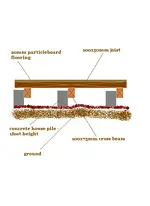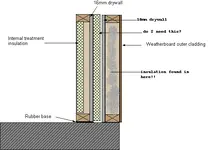Johnrg
New member
Hi Guys,
posted this on Sayers site but thought someone here nmight be able to help as well:
Well after alot more reading and info gathering I have found my room weight was slightly wrong due to a dodgy kg to pounds conversion.
My room will be 4700pounds including two people and the gear.
This room will be constructed with the inside out system with two layers of 13mm plasterboard, floated floor on 90x45mm etc.
If I work on another members tests one 90x45x25mm (3 1/2x 1 1/2 x 1) puck (Neoprene-60duro) will take about 300pounds of pressure to acheive 10/15% compression. This basically means I need approx 15pucks.
My floor aera is 11.04m2(118sqfeet).
So I need One puck every .736m2 (7.9sqfeet).
This is fine, and sounds OK in principle however the original wooden floor joists that I am building overtop off run at 600mm centers (23inchs) from the existing wall and I have been told many times that my new pucks must rest where the existing joists run in the existing floor.
Because I am starting my new floor and walls about 100mm out from this existing wall I cannot put them at .736m intervals and have them placed on the original timber joists. The first one nearest the wall will not be on top of the origianl joist and so on (domino effect!!)
So what's worse, or best!!
(a)pucks that do not rest on the original joists but are correctly placed at .736m2 intervals to generate the correct spring for the expected room weight.
(b)about 25% more pucks than I need, therefore not creating the correct spring, but they will lie on top of the existing joists at 600m with extra not on top of joists around the edge of the room.
(c) What about if I reduct the puck size (not thickness). Will that have any effect on the amount I need?
Help appreciated everyone:
JG
posted this on Sayers site but thought someone here nmight be able to help as well:
Well after alot more reading and info gathering I have found my room weight was slightly wrong due to a dodgy kg to pounds conversion.
My room will be 4700pounds including two people and the gear.
This room will be constructed with the inside out system with two layers of 13mm plasterboard, floated floor on 90x45mm etc.
If I work on another members tests one 90x45x25mm (3 1/2x 1 1/2 x 1) puck (Neoprene-60duro) will take about 300pounds of pressure to acheive 10/15% compression. This basically means I need approx 15pucks.
My floor aera is 11.04m2(118sqfeet).
So I need One puck every .736m2 (7.9sqfeet).
This is fine, and sounds OK in principle however the original wooden floor joists that I am building overtop off run at 600mm centers (23inchs) from the existing wall and I have been told many times that my new pucks must rest where the existing joists run in the existing floor.
Because I am starting my new floor and walls about 100mm out from this existing wall I cannot put them at .736m intervals and have them placed on the original timber joists. The first one nearest the wall will not be on top of the origianl joist and so on (domino effect!!)
So what's worse, or best!!
(a)pucks that do not rest on the original joists but are correctly placed at .736m2 intervals to generate the correct spring for the expected room weight.
(b)about 25% more pucks than I need, therefore not creating the correct spring, but they will lie on top of the existing joists at 600m with extra not on top of joists around the edge of the room.
(c) What about if I reduct the puck size (not thickness). Will that have any effect on the amount I need?
Help appreciated everyone:
JG






 And if that wasn't enough, because it was a rental, I had to have the floor REPAIRED!!
And if that wasn't enough, because it was a rental, I had to have the floor REPAIRED!!  So take my word with a grain of salt if you so choose. My whole point was new information had come to light in regards to the criteria the makes floating a ROOM worth the time and expense. Hence my links to the discussions of said criteria OPINIONS!
So take my word with a grain of salt if you so choose. My whole point was new information had come to light in regards to the criteria the makes floating a ROOM worth the time and expense. Hence my links to the discussions of said criteria OPINIONS!  The only way I know of to be ABSOLUTELY sure you are meeting your isolation goals is to hire an Acoustical Engineer who takes responsibility for the results.
The only way I know of to be ABSOLUTELY sure you are meeting your isolation goals is to hire an Acoustical Engineer who takes responsibility for the results. At least the crowd that is concerned enough about their results that they take the time to address what IS KNOWN, and make informed descisions instead of relying solely on a few replies on a forum. And that is EXACTLY the problem here. This is a massive information problem on the net. My BEST advice, other than Steve knows much more than I do and to trust his word above mine, but also check those threads out in full. Lastly, I read about peoples success with the same sort of critera. Here is one from last month. Whether or not their ISOLATION results will meet YOUR criteria is another animal altogether.
At least the crowd that is concerned enough about their results that they take the time to address what IS KNOWN, and make informed descisions instead of relying solely on a few replies on a forum. And that is EXACTLY the problem here. This is a massive information problem on the net. My BEST advice, other than Steve knows much more than I do and to trust his word above mine, but also check those threads out in full. Lastly, I read about peoples success with the same sort of critera. Here is one from last month. Whether or not their ISOLATION results will meet YOUR criteria is another animal altogether.